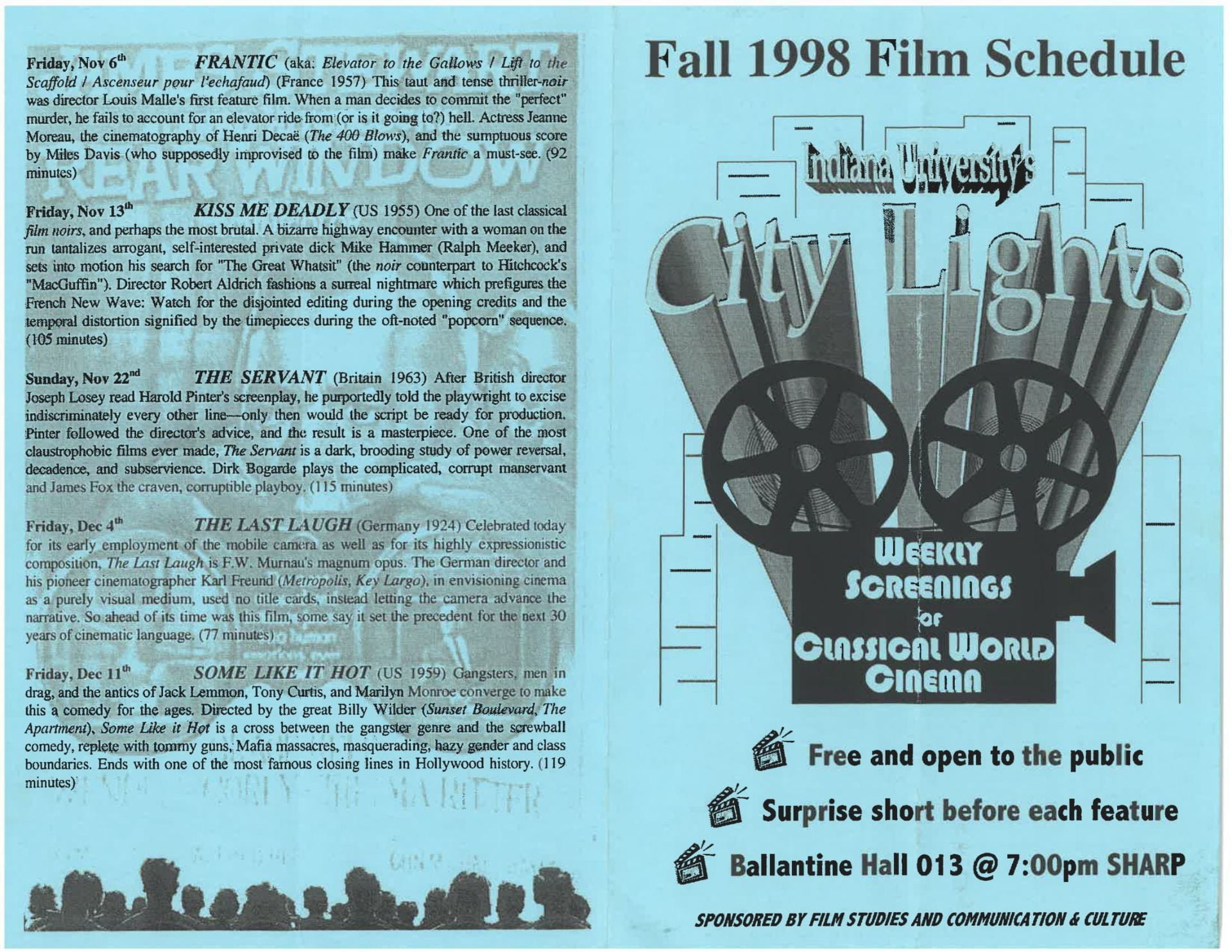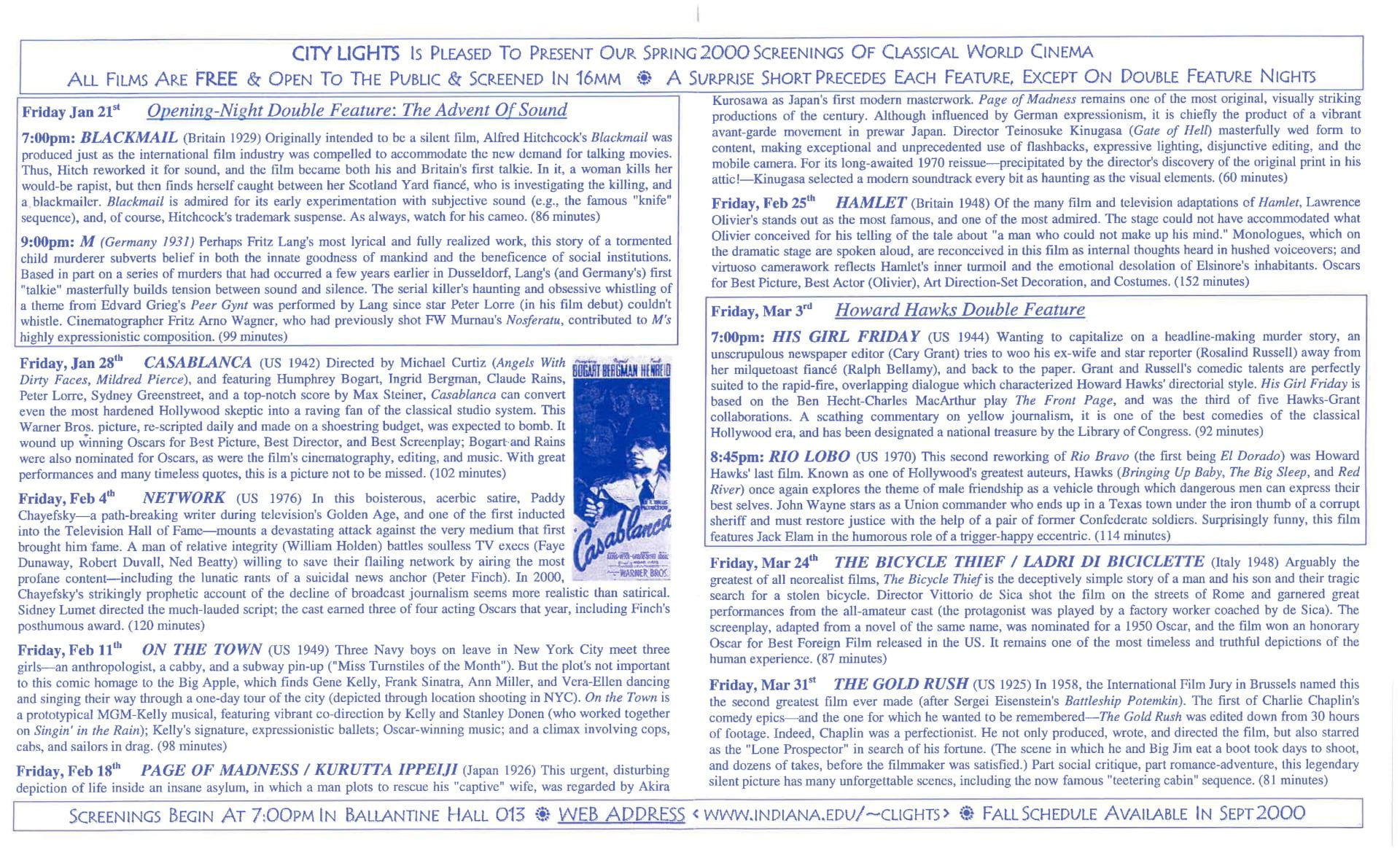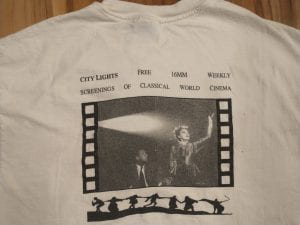
In 1997, two graduate students in the Indiana University Bloomington Film Studies program began the City Lights Film Series. Through City Lights, Drew Todd, now a senior lecturer at San José State University, and Eric Beckstrom, a senior academic advisor for the Indiana University Center for Students in Transition, offered “Free 16mm Weekly Screenings of Classical World Cinema.” For the series, Beckstrom and Todd tapped into a number of IU’s 16mm film collections, including the David S. Bradley collection. While 16mm screenings are no longer a part of its manifesto, the series is now in its 25th year, which coincides with the centennial of 16mm. What follows are Drew and Eric’s recollections.
Drew: I remember you and I becoming friends during our first year in the Film Studies graduate program, and pretty quickly noting that IU didn’t have a full-fledged film series. Both of us had been changed by film series at our respective colleges. We started talking about what it would look like to start our own on campus, using the university’s 16mm collection for starters. Next, we met with Jim (James Naremore, Chancellors’ Professor Emeritus of English and Comparative Literature), who wholeheartedly backed the idea and agreed to be our faculty sponsor. We secured an auditorium on campus for screenings and scheduled it for almost every Friday night during the semester. We’d start and end each semester’s lineup with a double bill and had the idea of showing a surprise short before each film on the other nights. As both of us were film studies/film history grad students, we often wanted to set up the series in ways that paid homage to earlier traditions in moviegoing; the movie short was certainly one such instance.
Eric: The audiences were delighted by the shorts, which included everything from Laurel and Hardy to Willis O’Brien’s Creation (1931) to, if I recall correctly, silent, German avant-garde. To choose our screening location, we visited every single auditorium on campus. We eliminated ones without enclosed projection booths and which we felt were too small. We settled on Ballantine 013 because it had an enclosed — albeit tiny — booth and was large enough to accommodate over 300 patrons. We were starry-eyed and believed we could fill it. Which we did on more than one occasion! We wished it had a bigger screen — of course we did — but it was the best option available. Little did we know that a bunch of years later our dream would come true and there would be a world-class cinema right in the heart of campus.
Drew: Speaking of our audience, do you remember the older gentleman, maybe in his 70s, with a crew cut and a cane, who came to every screening without fail? I recall occasionally showing obscure avant-garde films and thinking, “Nah, he won’t make it tonight,” and there he’d be in his usual spot up front!
Eric: I do remember him! He always gave us each a piece of butterscotch hard candy after the screenings. He’s the perfect example of what we wanted to do insofar as being a community film series, not just a campus series, and a good example of our “regulars,” whom we’d see week after week.
Drew: You’re so right — it was really important for us to make it a town-and-gown offering. We wanted our fellow students, both undergraduate and graduate, to enjoy the series and gain exposure to a wide range of classics, but we also wanted it to be very available to the community. So we made sure the series was always free and very much advertised throughout Bloomington. After we decided on Ballantine 013, we embarked upon this crazy outreach campaign: making posters and putting them up all over campus and town, spending hours putting together our flyers, hitting up senior centers in Bloomington and arranging for them to bus folks in, and on and on.
Eric: Yes, our motto was “Free 16mm Weekly Screenings of Classical World Cinema.” We even got seed money from Film Studies and had T-shirts made as part of our promotional campaign. We sold every one of them and so essentially had walking billboards around town. I also remember we had many very earnest conversations about how big the posters should be. We didn’t have the budget for full-color, so at first we printed them on plain old matte paper, blue paper for Fall semester and green for Spring. Then I think we got a little more money and went all fancy, printing the bi-fold flyers in monochrome red for Fall and monochrome blue for Spring. Ironically, we didn’t like the idea of B&W promotional material. We spent hours obsessing over flyer details. Neither of us had a clue how to use publishing software, so we used Word for Windows — which was most decidedly not publishing software. We messed around with margins, gutters, line spacing, font size, image size, all in an effort to squeeze in our movie “blurbs,” as we called them.
Every so often, I think about one particular such moment and laugh out loud. We were hunched behind my computer late one night finishing up the flyer ahead of our print deadline. You pointed to a movie poster image and asked, “Do you think we should move this half a millimeter to the left?” Long pause. Sidelong glance from me. “No,” you said, “I’m out of my f—ing mind, aren’t I?” Yes, you were. But we both were, and laughed like hell, as we often did.




Drew: We were pretty persnickety, weren’t we? Speaking of which, that first semester in Ballantine 013, I’m pretty sure we lost sleep over the light pollution in that auditorium. The doors had windows on them, letting in light from the hallways, so we figured out a method to cover them with laminated cut-outs that fit the windows perfectly, attaching them with velcro. Well, the janitorial staff ripped off the velcro pieces we put in place, not knowing what they were for. We proceeded to reach out to the building manager to clarify their purpose, got permission to reattach the velcro, and continued sealing out the light for each screening thereafter — and slept better, too.
Eric: Yes! And I also recall a well-intentioned janitor clanking around the long row of doors in the back of the auditorium in the middle of a couple of screenings. The place was full of people, but by God, he was gonna lock up those doors for the night. We again talked with the manager. He was a good guy, very understanding, and it never happened again.
Drew: I fondly recall the fun we had with scores. Most of our silent prints didn’t have score tracks, so we would get pretty creative, finding scores, recording them onto cassettes, and synching them up with the print as best we could. Once in a while, either the recording or the projector would stop and all chaos would ensue, but our audiences didn’t mind a bit. And we took solace in the fact that we were (unintentionally) recreating and demonstrating common synch problems with sound-on-disc technology, before the film industry figured out how to streamline sound on film!




Eric: One of my favorite memories is our — to use your word — persnickety efforts at doing seamless reel changes. Cramming ourselves into that stifling projection booth with two projectors and literally 20×30 inches of floor space, we watched for the cigarette burns on the film which warned of an upcoming reel change. We got pretty good at switching one projector off and the other on at exactly the right moment so the audience was, by and large, unaware of a reel change. I also remember that we often had to take turns steadying the film in a jittery projector, keeping a finger on the film to prevent it from jumping. We had to trade off because we’d burn our fingers. It never occurred to either of us that we could have worn a thin cotton glove to save some of the pain! And we were astonished at how much heat two projectors could throw!
Drew: That was one of my favorite parts of this project: learning how to work with projectors, prints, and collections. You and I both had our preferred films in the various collections we had access to, but we also each had gaps. For our first double bill, you introduced me to Buster Keaton’s Sherlock, Jr. (1924), which I still teach in my introductory film class. We paired that with Woody Allen’s Purple Rose of Cairo (1985), opening the series on a decided note of humorous homage and meta-cinema. In other cases, we were both exposed to films and prints we’d never heard of, let alone seen. In our second or third year, for instance, we discovered Teinosuke Kinugasa’s brilliant A Page of Madness (1926) and showed it with an avant-garde short.
Eric: Wow, I forgot about A Page of Madness. A real “gem” in the parlance of Drew The Graduate Student. One of our favorite and most rewarding, but most arduous, tasks was plumbing the depths of the collections and prescreening films to make sure they were in a condition worthy of public screening and weren’t missing frames or even entire scenes. We had to pass up some films we’d loved to have shown, but also discovered some incredible prints. A 16mm print of Chimes at Midnight (1965), come on! And we got to screen a ‘Scope print of Rear Window (1954) to a full house. Prescreening was especially challenging if neither of us had seen the given film. We had to do this in a tiny dark room, lost to the basement recesses of Franklin Hall, watching them on an equally tiny tripod screen with a roaring projector sitting next to us. Fortunately, after the first year of the series we had the indispensable help of a few other dedicated friends and graduate students. Mary, Joe, Bjorn, and everyone, if you’re reading this, thank you — we couldn’t have done it without you!
Celebrate the 25th anniversary of the City Lights series with Alfred Hitchcock’s classic paranoid whodunit Rear Window on February 16. A Q&A with City Lights curator and PhD student Caleb Allison and IU Libraries Moving Image Archive Director Rachael Stoeltje will follow the screening.
Other City Lights titles this season include They Shoot Horses, Don’t They? on February 25 and A Man Escaped on March 4.

